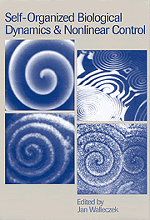 Self-Organized Biological Dynamics and Nonlinear Control
Self-Organized Biological Dynamics and Nonlinear Control Published online by Cambridge University Press: 14 August 2009
Introduction
We think of the brain as our very own computer, a never-ending process of signaling, providing overall guidance for the body and ultimately defining who we are. A multitude of signaling means has evolved for this task, combining mechanical, chemical and electrical communication into a complex network. As we consider the diversity among the types of signal present in the brain, it is not surprising that dynamical processes are also utilized to deliver its messages. Signals of electrical origin are particularly suitable for modulation in time. We see direct evidence of this by examining an electroencephalogram (EEG) or its magnetic counterpart, the magnetoencephalogram (MEG). These techniques provide ways of visualizing the natural rhythms occurring during various brain activities.
The hippocampus is an important structure in the brain that is particularly interesting within the context of dynamical signaling. It is central to the seemingly disparate phenomena of memory function and epilepsy. These two expressions of hippocampal activity are associated with normal and pathological behavior, both of which turn out to be responsive to manipulation with drugs as well as magnetic fields. In vitro studies of the rat hippocampus led us to conclude that an externally applied magnetic field with a steady low-frequency oscillation is capable of mimicking the function of nitric oxide (NO) in this model system. Rhythmic slow activity (RSA, or theta rhythm), which is correlated with learning and attention, is modified when the NO pathway is manipulated, either with drugs or with a low-frequency magnetic flux density of about 50 to 500 microtesla (μT).
To save this book to your Kindle, first ensure [email protected] is added to your Approved Personal Document E-mail List under your Personal Document Settings on the Manage Your Content and Devices page of your Amazon account. Then enter the ‘name’ part of your Kindle email address below. Find out more about saving to your Kindle.
Note you can select to save to either the @free.kindle.com or @kindle.com variations. ‘@free.kindle.com’ emails are free but can only be saved to your device when it is connected to wi-fi. ‘@kindle.com’ emails can be delivered even when you are not connected to wi-fi, but note that service fees apply.
Find out more about the Kindle Personal Document Service.
To save content items to your account, please confirm that you agree to abide by our usage policies. If this is the first time you use this feature, you will be asked to authorise Cambridge Core to connect with your account. Find out more about saving content to Dropbox.
To save content items to your account, please confirm that you agree to abide by our usage policies. If this is the first time you use this feature, you will be asked to authorise Cambridge Core to connect with your account. Find out more about saving content to Google Drive.